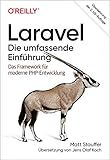Best Laravel JSON Response Practices to Buy in December 2025
To return a JSON response in Laravel, you can follow the steps below:
- Ensure that your Laravel application has the necessary routes and controllers set up.
- Use the response() global function to create a new response instance with JSON data.
- Pass an associative array or an object to the json() method of the response instance, which will convert it to JSON format.
- You can also use the json() helper function to directly return a JSON response without creating a response instance.
Here is an example of returning a JSON response in Laravel:
use Illuminate\Http\Request; use Illuminate\Support\Facades\Route;
Route::get('/api/user/{id}', function (Request $request, $id) { $user = User::find($id);
// Create a response instance and convert data to JSON
return response()->json($user);
});
// Alternative approach using the json() helper function Route::get('/api/users', function () { $users = User::all();
// Return a JSON response without creating a response instance
return json\_encode($users);
});
In the first example, the response()->json($user) statement converts the $user object to JSON format and returns it as the response. The second example uses the json_encode() function to convert the $users array to JSON and returns it directly without creating a response instance.
What is the default content type for a JSON response in Laravel?
The default content type for a JSON response in Laravel is application/json.
How to handle cross-origin requests and return a JSON response in Laravel?
To handle cross-origin requests and return a JSON response in Laravel, you can follow the steps mentioned below:
- Install the fruitcake/laravel-cors package: Run the following command in your terminal to install the package: composer require fruitcake/laravel-cors
- Add the CORS middleware to the global middleware or specific route middleware group in app/Http/Kernel.php: protected $middleware = [ // ... \Fruitcake\Cors\HandleCors::class, ];
- Publish the configuration file for the CORS package: Run the following command in your terminal to publish the configuration file: php artisan vendor:publish --provider="Fruitcake\Cors\CorsServiceProvider" This will create config/cors.php file where you can configure the CORS settings as per your requirements.
- Configure the CORS settings in config/cors.php file. For example, you can allow all origins and methods and set the necessary headers: return [ 'paths' => ['api/*'], // Set the paths for which you want to enable CORS 'allowed_methods' => ['*'], // Allow all methods 'allowed_origins' => ['*'], // Allow all origins 'allowed_headers' => ['*'], // Allow all headers ];
- In your controller method, you can return a JSON response by using the response helper function: public function yourMethod() { // Do your logic here // Return a JSON response return response()->json(['message' => 'Success']); }
That's it! Now your Laravel application will handle cross-origin requests and return JSON responses. Make sure to configure your CORS settings according to your specific requirements.
How to return a JSON response with multiple data sets in Laravel?
To return a JSON response with multiple data sets in Laravel, you can use the "response" helper function to create a JSON response and pass an array of data as the second argument. Here is an example:
use Illuminate\Http\Request;
public function getData(Request $request) { $data1 = // retrieve the first data set $data2 = // retrieve the second data set
return response()->json(\[$data1, $data2\]);
}
In this example, you can retrieve the desired data sets and pass them as an array to the "json" method of the response helper function. This will create a JSON response containing both data sets.
How to handle authentication and authorization in a JSON response in Laravel?
In Laravel, authentication and authorization are typically handled using middleware and the built-in Laravel Passport package. Here is a step-by-step guide on how to handle authentication and authorization in a JSON response in Laravel:
- Install Laravel Passport package by running the following command: composer require laravel/passport
- Once the package is installed, run the migration command to create the necessary tables: php artisan migrate
- Next, publish the Passport configuration files by running the following command: php artisan passport:install
- Add the HasApiTokens trait to your User model. Open the User model and add the following code: use Laravel\Passport\HasApiTokens; class User extends Authenticatable { use HasApiTokens; }
- In your config/auth.php configuration file, make sure the api guard is set to use passport driver: 'guards' => [ // ... 'api' => [ 'driver' => 'passport', 'provider' => 'users', ], ],
- Define a route to handle user authentication. In your routes/api.php file, add the following code: Route::post('login', 'AuthController@login');
- Create a new controller named AuthController using the following command: php artisan make:controller AuthController
- Open the AuthController.php file and add the following code to handle user login: use Illuminate\Support\Facades\Auth; class AuthController extends Controller { public function login(Request $request) { $credentials = $request->only('email', 'password'); if (Auth::attempt($credentials)) { $user = Auth::user(); $token = $user->createToken('MyApp')->accessToken; return response()->json(['token' => $token], 200); } return response()->json(['error' => 'Unauthorized'], 401); } }
- To protect your API routes, add the auth:api middleware. For example, in your routes/api.php file: Route::middleware('auth:api')->group(function () { Route::get('users', 'UserController@index'); });
- Now, to authorize access to the protected API routes, you can use the can middleware. For example, in your UserController.php file:
use Illuminate\Support\Facades\Gate;
class UserController extends Controller { public function index() { if (Gate::allows('view-users')) { // Authorized to view users return response()->json(User::all(), 200); }
return response()->json(\['error' => 'Unauthorized'\], 401);
}
}
- To define abilities and roles, you can use Laravel's built-in Authorization Gates and Policies. For example, in your AuthServiceProvider.php file:
use App\Models\User; use Illuminate\Support\Facades\Gate;
class AuthServiceProvider extends ServiceProvider { protected $policies = [ User::class => UserPolicy::class, ];
public function boot()
{
$this->registerPolicies();
Gate::define('view-users', function ($user) {
return $user->hasRole('admin');
});
}
}
By following these steps, you can handle authentication and authorization in a JSON response in Laravel using Laravel Passport and middleware.




